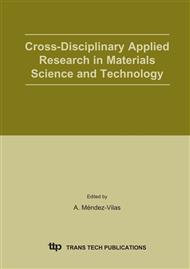p.1
p.13
p.21
p.27
p.33
p.43
p.53
p.59
Photoelectrochemical Measurements on Cathodically Electrodeposited Films of Cadmium and Zinc Chalcogenide Compounds
Abstract:
A variety of electrochemical and electrical techniques is employed in order to determine useful parameters of the optical behaviour of thin semiconducting films. In particular, this work is intended to the characterization of cathodically electrodeposited binary and ternary cadmium and zinc selenides and tellurides by photoelectrochemical (PEC) tests. Typical solid-state techniques, such as reflection, laser assisted photoreflection, resistivity and Hall effect measurements are used as well. A plain relation between crystal structure/film morphology and PEC behavior is established so long as the electrochemical preparation method is capable to explicitly control the deposit structure. In certain cases, a particular charge transfer mechanism in the semiconductor, associated with the existence of a nanostructure, is shown to result in higher photoconversion efficiencies as compared to larger-grained films.
Info:
Periodical:
Pages:
1-12
Citation:
Online since:
March 2005
Authors:
Price:
Сopyright:
© 2005 Trans Tech Publications Ltd. All Rights Reserved
Share:
Citation:


